Abstract
An 18-yr-old black woman in good general health was found to lack serum hemolytic complement activity. The sixth component of complement (C6) was undetectable by functional assay of serum or plasma and by immunoprecipitin analysis of serum. Functional titers of all other complement components were normal. The absence of C6 in the patient's serum could not be accounted for by a circulating C6 inhibitor, and addition of functionally pure C6 to the patient's serum restored hemolytic activity to normal. Both parents of the proband and five of six available siblings had approximately half the normal levels of functional C6. The other sibling had a normal C6 level. These data suggest that both parents and five siblings are heterozygous for C6 deficiency, while the proband is homozygous and one sibling is normal. Thus, C6 deficiency appears to follow classic mendelian inheritance, with all three possible genotypes recognizable within the family. Functional properties of the proband's C6-deficient serum included total absence of bactericidal activity against Salmonella typhi 0 901 and Hemophilus influenzae, type b, and inability to mediate lysis of red blood cells from patients with paroxysmal nocturnal hemoglobinuria in either the acidified serum or "sugar water" tests. The proband's serum did, however, exhibit a normal capacity (a) to generate chemotactic activity during incubation with bacterial endotoxin or aggregated IgG, (b) to mediate the immune adherence phenomenon, and (c) to coat human red blood cells, sensitized by cold agglutinins, with C4 and C3.
Full text
PDF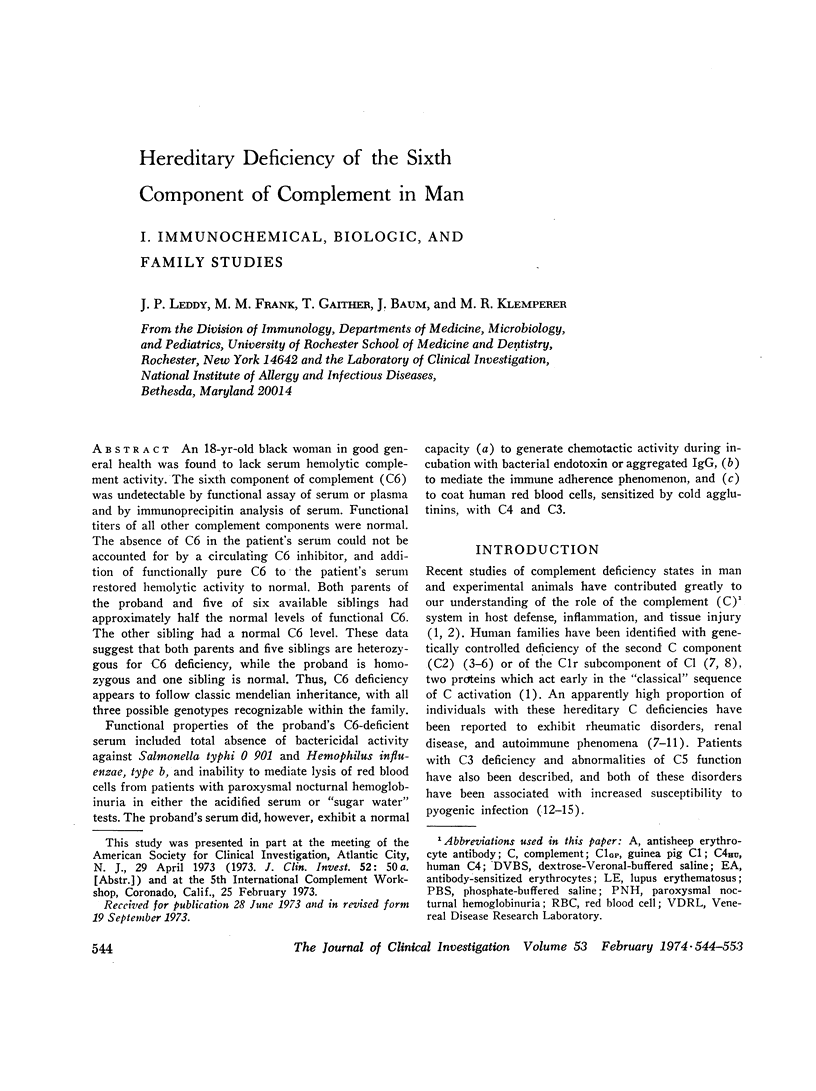
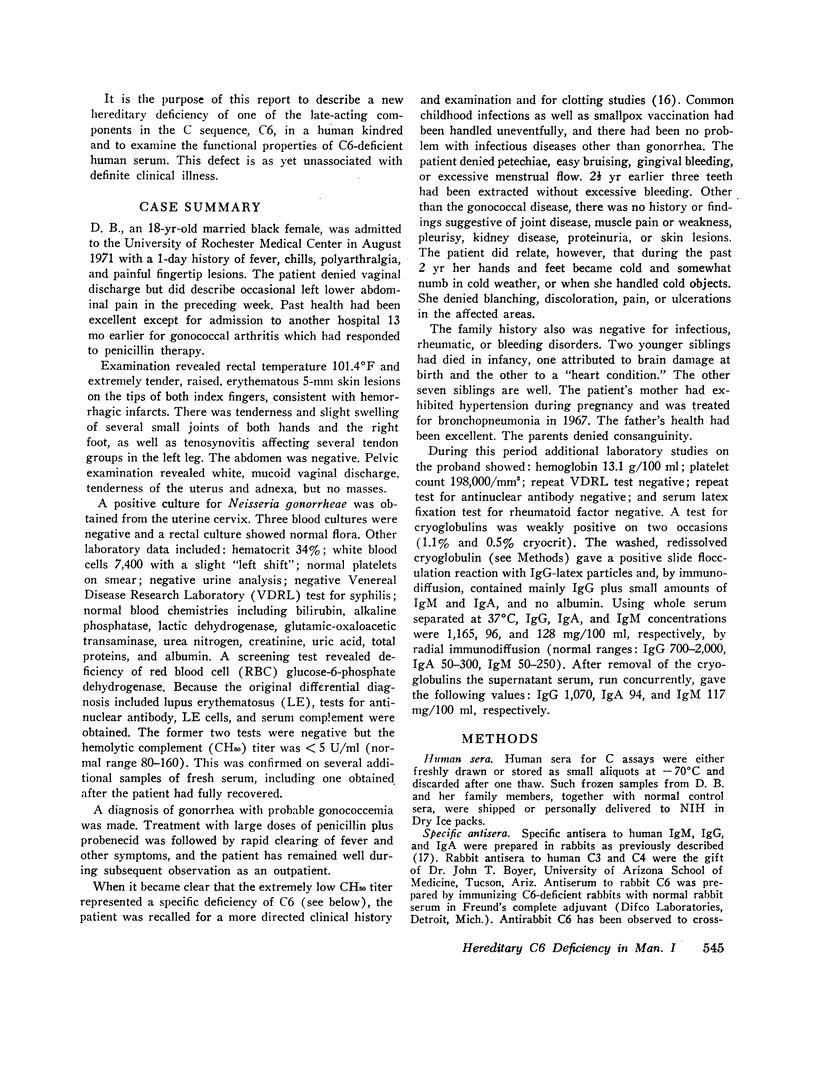
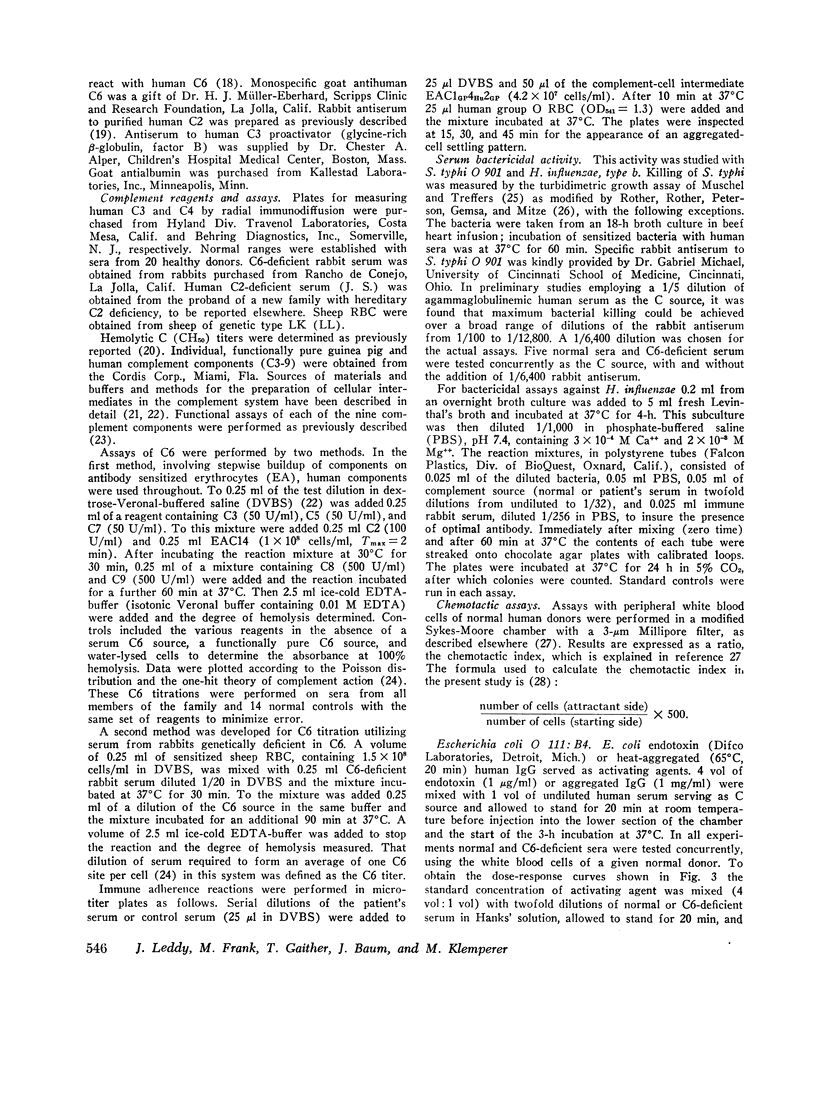
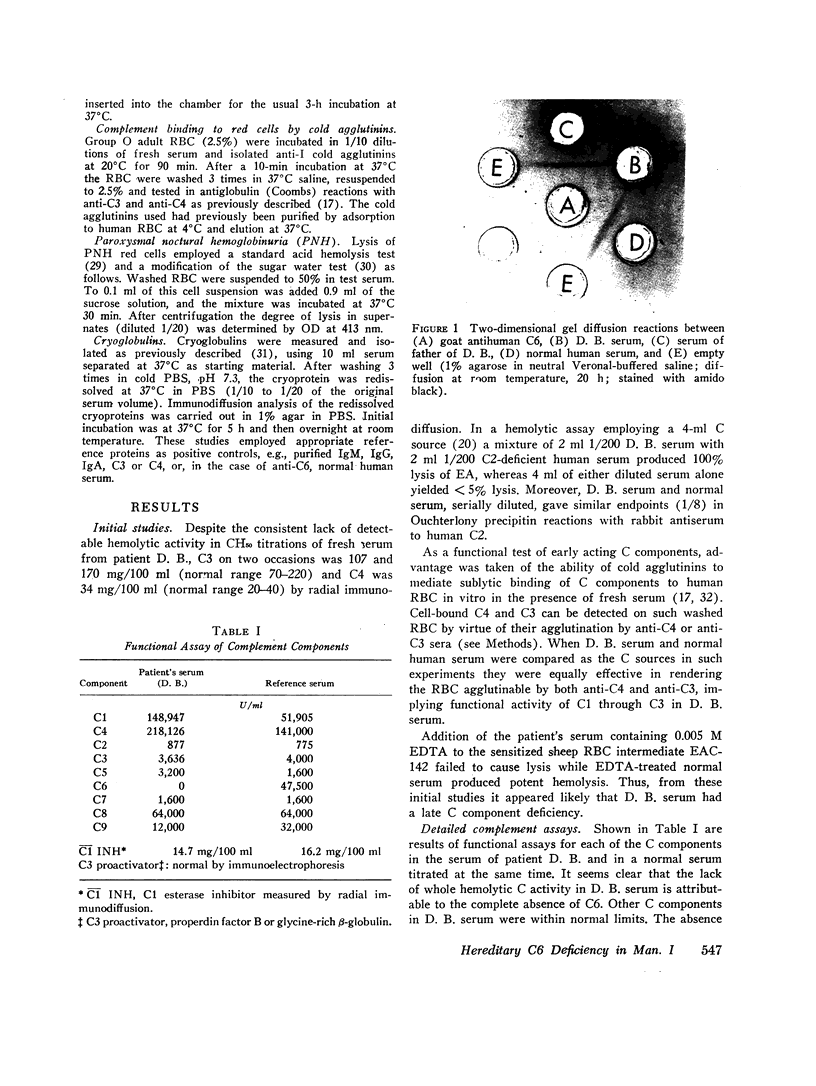
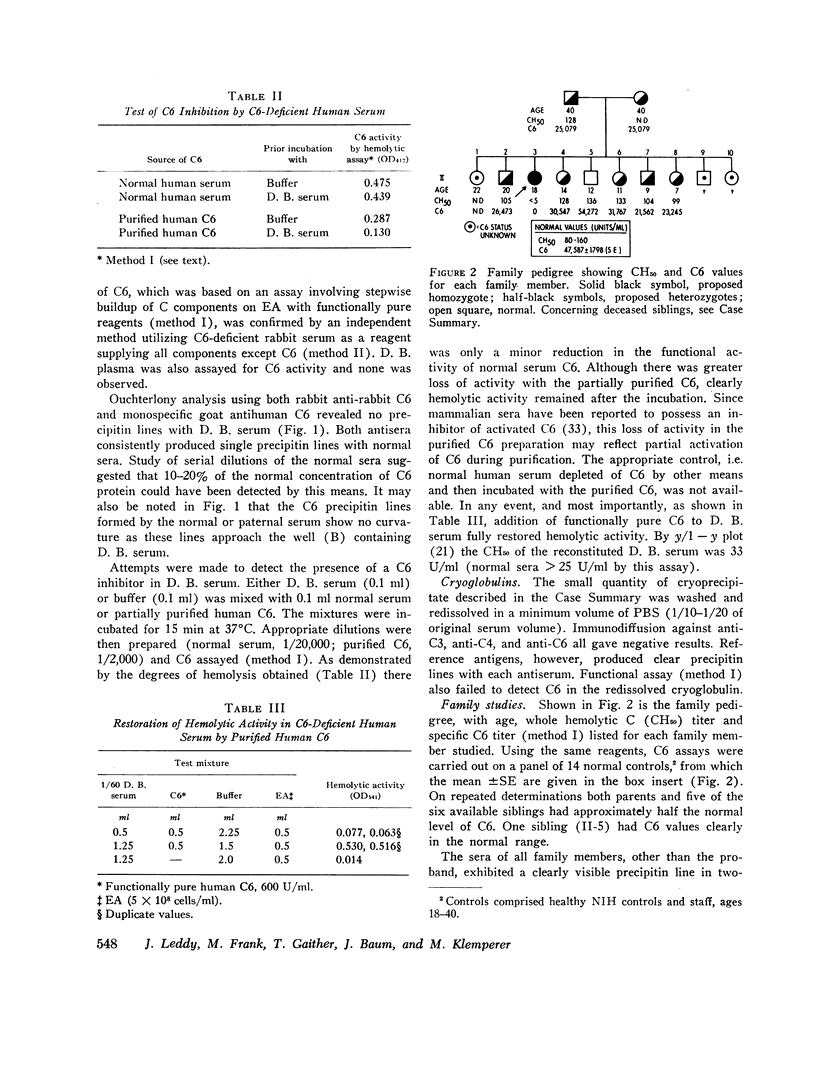
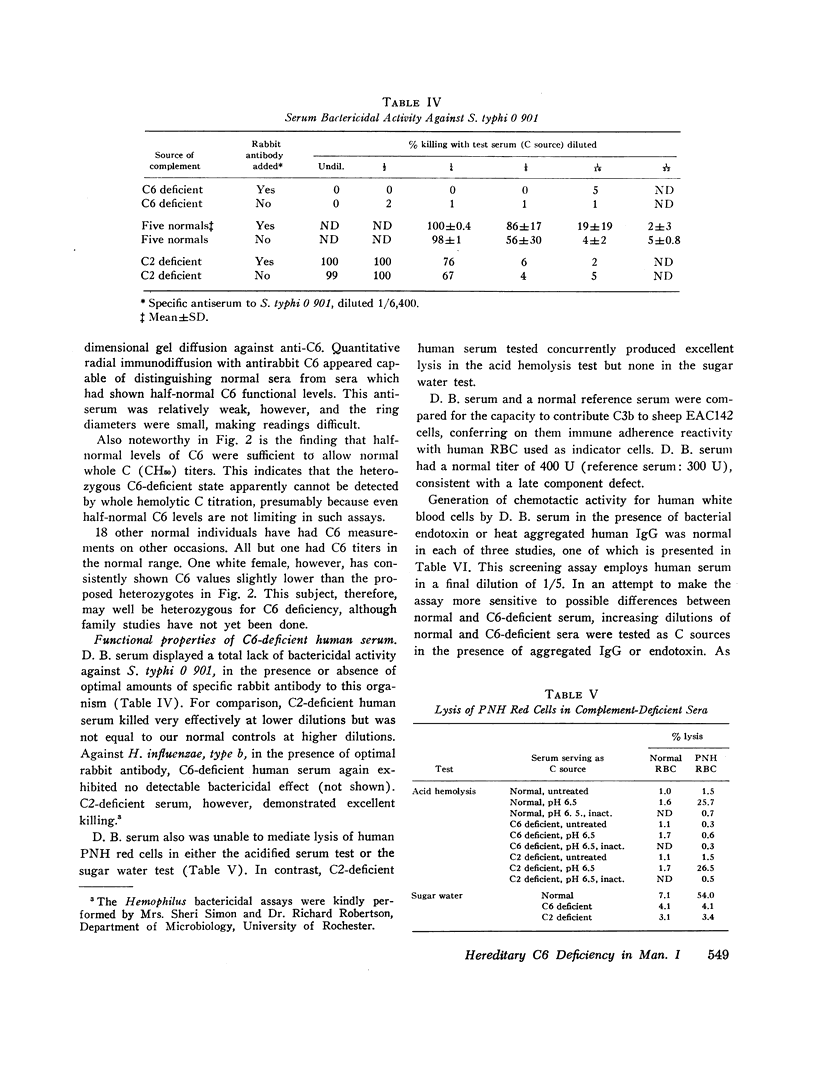
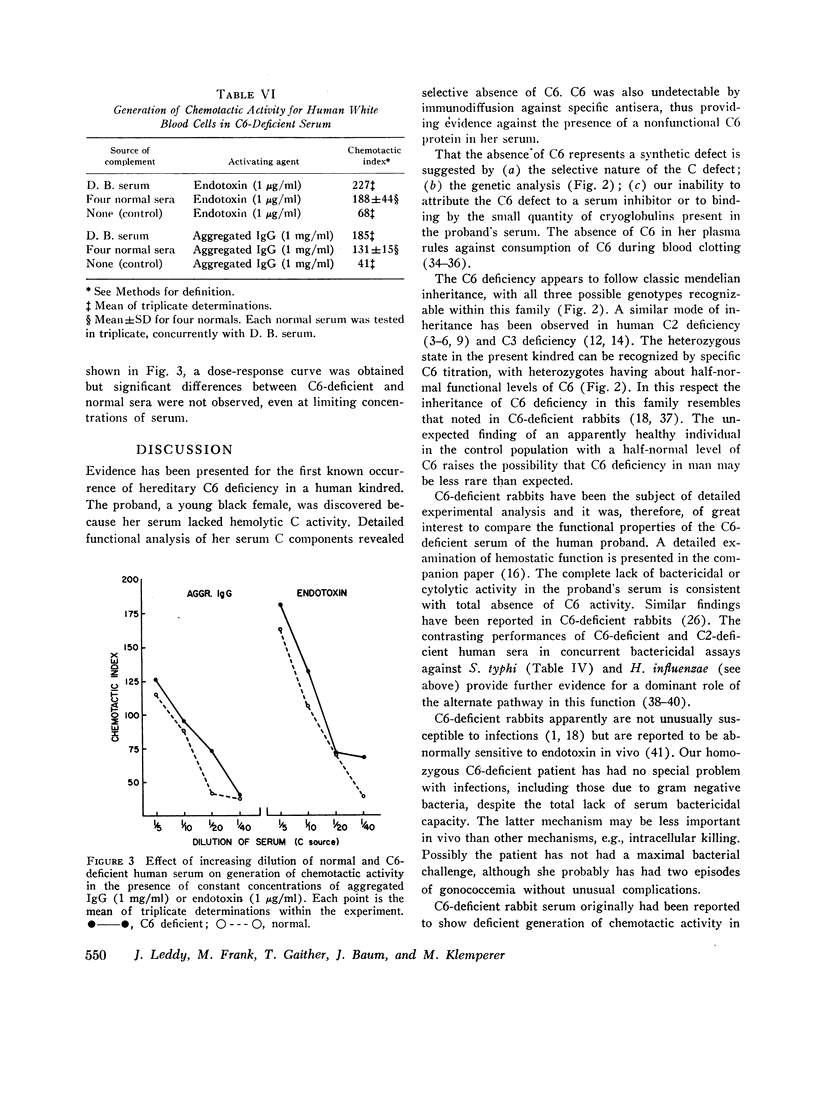
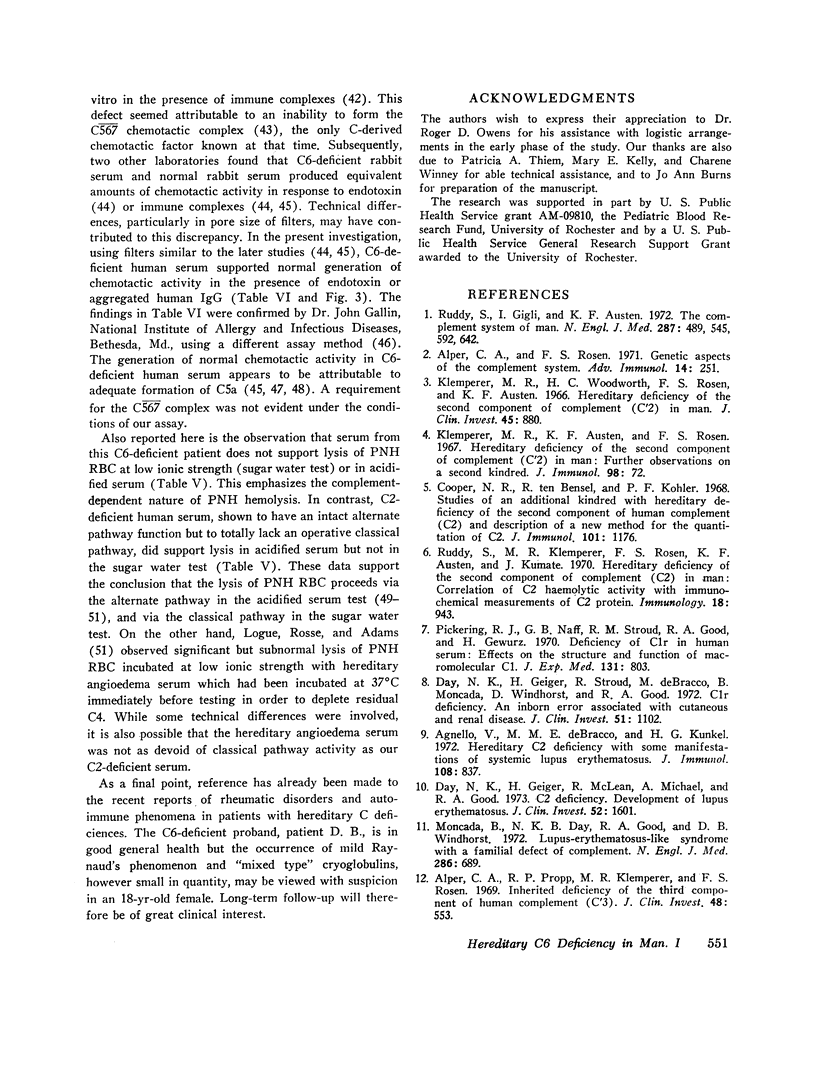
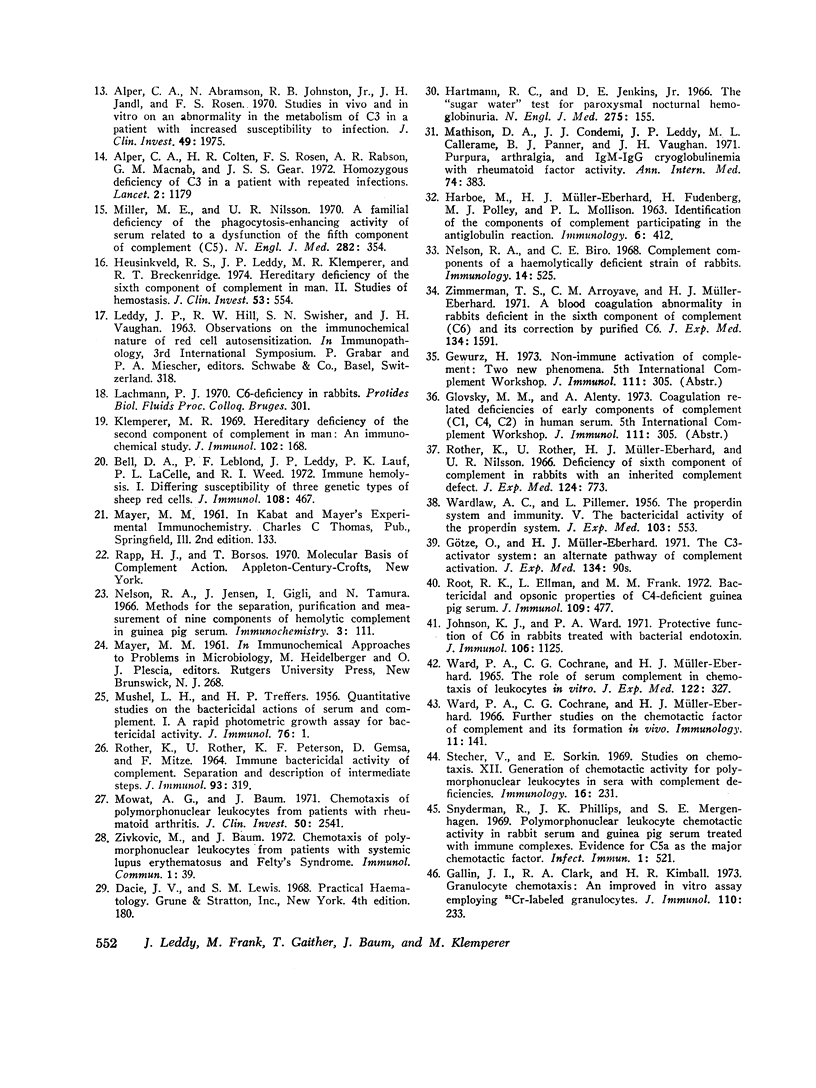
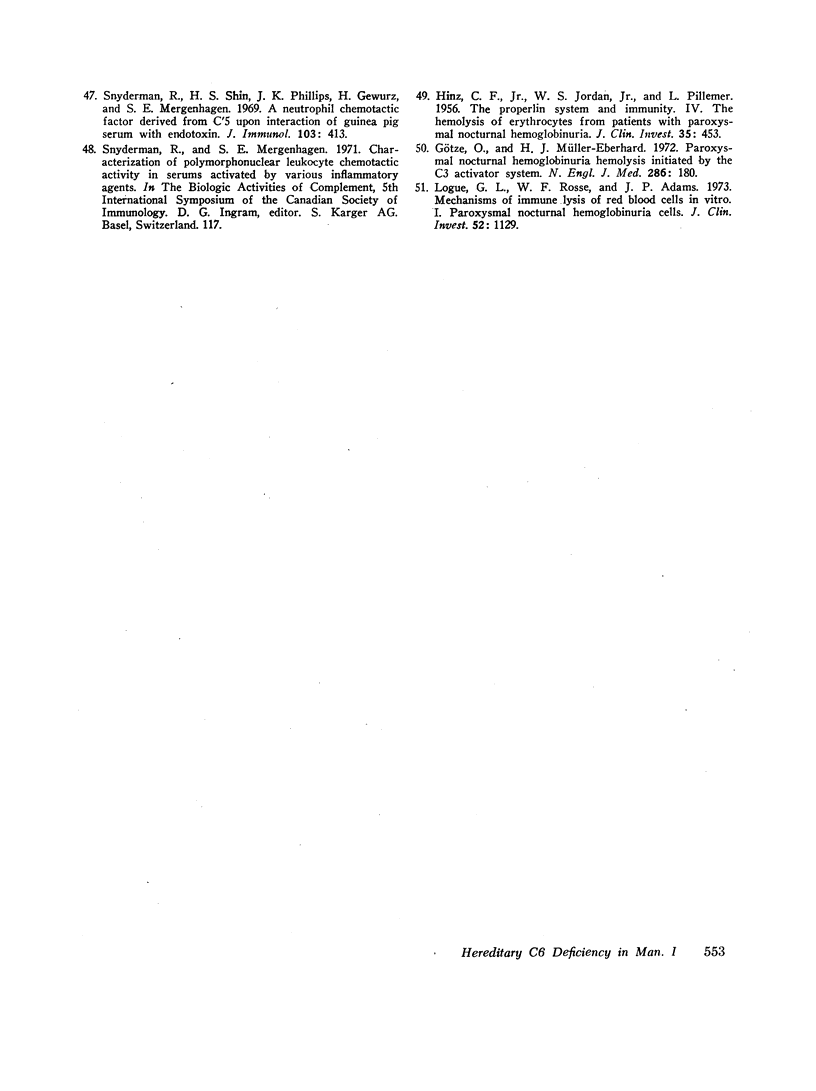
Images in this article
Selected References
These references are in PubMed. This may not be the complete list of references from this article.
- Agnello V., De Bracco M. M., Kunkel H. G. Hereditary C2 deficiency with some manifestations of systemic lupus erythematosus. J Immunol. 1972 Mar;108(3):837–840. [PubMed] [Google Scholar]
- Alper C. A., Abramson N., Johnston R. B., Jr, Jandl J. H., Rosen F. S. Studies in vivo and in vitro on an abnormality in the metabolism of C3 in a patient with increased susceptibility to infection. J Clin Invest. 1970 Nov;49(11):1975–1985. doi: 10.1172/JCI106417. [DOI] [PMC free article] [PubMed] [Google Scholar]
- Alper C. A., Colten H. R., Rosen F. S., Rabson A. R., Macnab G. M., Gear J. S. Homozygous deficiency of C3 in a patient with repeated infections. Lancet. 1972 Dec 2;2(7788):1179–1181. doi: 10.1016/s0140-6736(72)92598-6. [DOI] [PubMed] [Google Scholar]
- Alper C. A., Propp R. P., Klemperer M. R., Rosen F. S. Inherited deficiency of the third component of human complement (C'3). J Clin Invest. 1969 Mar;48(3):553–557. doi: 10.1172/JCI106013. [DOI] [PMC free article] [PubMed] [Google Scholar]
- Alper C. A., Rosen F. S. Genetic aspects of the complement system. Adv Immunol. 1971;14:251–290. doi: 10.1016/s0065-2776(08)60286-2. [DOI] [PubMed] [Google Scholar]
- Bell D. A., Leblond P. F., Leddy J. P., Lauf P. K., LaCelle P. L., Weed R. I. Immune hemolysis. I. Differing susceptibility of three genetic types of sheep red cells. J Immunol. 1972 Feb;108(2):467–474. [PubMed] [Google Scholar]
- Cooper N. R., ten Bensel R., Kohler P. F. Studies of an additional kindred with hereditary deficiency of the second component of human complement (C2) and description of a new method for the quantitation of C2. J Immunol. 1968 Dec;101(6):1176–1182. [PubMed] [Google Scholar]
- Day N. K., Geiger H., McLean R., Michael A., Good R. A. C2 deficiency. Development of lupus erythematosus. J Clin Invest. 1973 Jul;52(7):1601–1607. doi: 10.1172/JCI107337. [DOI] [PMC free article] [PubMed] [Google Scholar]
- Day N. K., Geiger H., Stroud R., DeBracco M., Mancaido B., Windhorst D., Good R. A. C1r deficiency: an inborn error associated with cutaneous and renal disease. J Clin Invest. 1972 May;51(5):1102–1108. doi: 10.1172/JCI106902. [DOI] [PMC free article] [PubMed] [Google Scholar]
- Gallin J. I., Clark R. A., Kimball H. R. Granulocyte chemotaxis: an improved in vitro assay employing 51 Cr-labeled granulocytes. J Immunol. 1973 Jan;110(1):233–240. [PubMed] [Google Scholar]
- Götze O., Müller-Eberhard H. J. Paroxysmal nocturnal hemoglobinuria. Hemolysis initiated by the C3 activator system. N Engl J Med. 1972 Jan 27;286(4):180–184. doi: 10.1056/NEJM197201272860403. [DOI] [PubMed] [Google Scholar]
- Götze O., Müller-Eberhard H. J. The C3-activator system: an alternate pathway of complement activation. J Exp Med. 1971 Sep 1;134(3 Pt 2):90s–108s. [PubMed] [Google Scholar]
- HARBOE M., MUELLER-EBERHARD H. J., FUDENBERG H., POLLY M. J., MOLLISON P. L. IDENTIFICATION OF THE COMPONENTS OF COMPLEMENT PARTICIPATING IN THE ANTIGLOBULIN REACTION. Immunology. 1963 Jul;6:412–420. [PMC free article] [PubMed] [Google Scholar]
- HINZ C. F., Jr, JORDAN W. S., Jr, PILLEMER L. The properdin system and immunity. IV. The hemolysis of erythrocytes from patients with paroxysmal nocturnal hemoglobinuria. J Clin Invest. 1956 May;35(5):453–457. doi: 10.1172/JCI103296. [DOI] [PMC free article] [PubMed] [Google Scholar]
- Hartmann R. C., Jenkins D. E. The "sugar-water" test for paroxysmal nocturnal hemoglobinuria. N Engl J Med. 1966 Jul 21;275(3):155–157. doi: 10.1056/NEJM196607212750308. [DOI] [PubMed] [Google Scholar]
- Heusinkveld R. S., Leddy J. P., Klemperer M. R., Breckenridge R. T. Hereditary deficiency of the sixth component of complement in man. II. Studies of hemostasis. J Clin Invest. 1974 Feb;53(2):554–558. doi: 10.1172/JCI107589. [DOI] [PMC free article] [PubMed] [Google Scholar]
- Johnson K. J., Ward P. A. Protective function of C6 in rabbits treated with bacterial endotoxin. J Immunol. 1971 Apr;106(4):1125–1127. [PubMed] [Google Scholar]
- Klemperer M. R., Austen K. F., Rosen F. S. Hereditary deficiency of the second component of complement (C'2) in man: further observations on a second kindred. J Immunol. 1967 Jan;98(1):72–78. [PubMed] [Google Scholar]
- Klemperer M. R. Hereditary deficiency of the second component of complement in man: an immunochemical study. J Immunol. 1969 Jan;102(1):168–171. [PubMed] [Google Scholar]
- Klemperer M. R., Woodworth H. C., Rosen F. S., Austen K. F. Hereditary deficiency of the second component of complement (C'2) in man. J Clin Invest. 1966 Jun;45(6):880–890. doi: 10.1172/JCI105403. [DOI] [PMC free article] [PubMed] [Google Scholar]
- Logue G. L., Rosse W. F., Adams J. P. Mechanisms of immune lysis of red blood cells in vitro. I. Paroxysmal nocturnal hemoglobinuria cells. J Clin Invest. 1973 May;52(5):1129–1137. doi: 10.1172/JCI107279. [DOI] [PMC free article] [PubMed] [Google Scholar]
- MUSCHEL L. H., TREFFERS H. P. Quantitative studies on the bactericidal actions of serum and complement. I. A rapid photometric growth assay for bactericidal activity. J Immunol. 1956 Jan;76(1):1–10. [PubMed] [Google Scholar]
- Mathison D. A., Condemi J. J., Leddy J. P., Callerame M. L., Panner B. J., Vaughan J. H. Purpura, arthralgia, and IgM-IgM cryoglobulinemia with rheumatoid factor acrivity. Response to cyclophosphamide and splenectomy. Ann Intern Med. 1971 Mar;74(3):383–390. doi: 10.7326/0003-4819-74-3-383. [DOI] [PubMed] [Google Scholar]
- Miller M. E., Nilsson U. R. A familial deficiency of the phagocytosis-enhancing activity of serum related to a dysfunction of the fifth component of complement (C5). N Engl J Med. 1970 Feb 12;282(7):354–358. doi: 10.1056/NEJM197002122820702. [DOI] [PubMed] [Google Scholar]
- Moncada B., Day N. K., Good R. A., Windhorst D. B. Lupus-erythematosus-like syndrome with a familial defect of complement. N Engl J Med. 1972 Mar 30;286(13):689–693. doi: 10.1056/NEJM197203302861304. [DOI] [PubMed] [Google Scholar]
- Mowat A. G., Baum J. Chemotaxis of polymorphonuclear leukocytes from patients with rheumatoid arthritis. J Clin Invest. 1971 Dec;50(12):2541–2549. doi: 10.1172/JCI106754. [DOI] [PMC free article] [PubMed] [Google Scholar]
- Nelson R. A., Jr, Jensen J., Gigli I., Tamura N. Methods for the separation, purification and measurement of nine components of hemolytic complement in guinea-pig serum. Immunochemistry. 1966 Mar;3(2):111–135. doi: 10.1016/0019-2791(66)90292-8. [DOI] [PubMed] [Google Scholar]
- Pickering R. J., Naff G. B., Stroud R. M., Good R. A., Gewurz H. Deficiency of C1r in human serum. Effects on the structure and function of macromolecular C1. J Exp Med. 1970 Apr 1;131(4):803–815. doi: 10.1084/jem.131.4.803. [DOI] [PMC free article] [PubMed] [Google Scholar]
- ROTHER K., ROTHER U., PETERSEN K. F., GEMSA D., MITZE F. IMMUNE BACTERICIDAL ACTIVITY OF COMPLEMENT. SEPARATION AND DESCRIPTION OF INTERMEDIATE STEPS. J Immunol. 1964 Aug;93:319–330. [PubMed] [Google Scholar]
- Root R. K., Ellman L., Frank M. M. Bactericidal and opsonic properties of C4-deficient guinea pig serum. J Immunol. 1972 Sep;109(3):477–486. [PubMed] [Google Scholar]
- Rother K., Rother U., Müller-Eberhard H. J., Nilsson J. R. Deficiency of the sixth component of complement in rabbits with an inherited complement defect. J Exp Med. 1966 Oct 1;124(4):773–785. doi: 10.1084/jem.124.4.773. [DOI] [PMC free article] [PubMed] [Google Scholar]
- Ruddy S., Gigli I., Austen K. F. The complement system of man (second of four parts). N Engl J Med. 1972 Sep 14;287(11):545–549. doi: 10.1056/NEJM197209142871106. [DOI] [PubMed] [Google Scholar]
- Ruddy S., Klemperer M. R., Rosen F. S., Austen K. F., Kumate J. Hereditary deficiency of the second component of complement (C2) in man: correlation of C2 haemolytic activity with immunochemical measurements of C2 protein. Immunology. 1970 Jun;18(6):943–954. [PMC free article] [PubMed] [Google Scholar]
- Snyderman R., Phillips J., Mergenhagen S. E. Polymorphonuclear leukocyte chemotactic activity in rabbit serum and Guinea pig serum treated with immune complexes: evidence for c5a as the major chemotactic factor. Infect Immun. 1970 Jun;1(6):521–525. doi: 10.1128/iai.1.6.521-525.1970. [DOI] [PMC free article] [PubMed] [Google Scholar]
- Snyderman R., Shin H. S., Phillips J. K., Gewurz H., Mergenhagen S. E. A neutrophil chemotatic factor derived from C'5 upon interaction of guinea pig serum with endotoxin. J Immunol. 1969 Sep;103(3):413–422. [PubMed] [Google Scholar]
- Stecher V. J., Sorkin E. Studies on chemotaxis. XII. Generation of chemotactic activity for polymorphonuclear leucocytes in sera with complement dificiencies. Immunology. 1969 Feb;16(2):231–239. [PMC free article] [PubMed] [Google Scholar]
- WARDLAW A. C., PILLEMER L. The properdin system and immunity. V. The bactericidal activity of the properdin system. J Exp Med. 1956 May 1;103(5):553–575. doi: 10.1084/jem.103.5.553. [DOI] [PMC free article] [PubMed] [Google Scholar]
- WARD P. A., COCHRANE C. G., MUELLER-EBERHARD H. J. THE ROLE OF SERUM COMPLEMENT IN CHEMOTAXIS OF LEUKOCYTES IN VITRO. J Exp Med. 1965 Aug 1;122:327–346. doi: 10.1084/jem.122.2.327. [DOI] [PMC free article] [PubMed] [Google Scholar]
- Ward P. A., Cochrane C. G., Muller-Eberhard H. J. Further studies on the chemotactic factor of complement and its formation in vivo. Immunology. 1966 Aug;11(2):141–153. [PMC free article] [PubMed] [Google Scholar]
- Zimmerman T. S., Arroyove C. M., Müller-Eberhard H. J. A blood coagulation abnormality in rabbits deficient in the sixth component of complement (C6) and its correction by purified C6. J Exp Med. 1971 Dec 1;134(6):1591–1600. doi: 10.1084/jem.134.6.1591. [DOI] [PMC free article] [PubMed] [Google Scholar]
- Zivkovic M., Baum J. Chemotaxis of polymorphonuclear leukocytes from patients with systemic lupus erythematosus and Felty's syndrome. Immunol Commun. 1972;1(1):39–49. doi: 10.3109/08820137209022891. [DOI] [PubMed] [Google Scholar]



